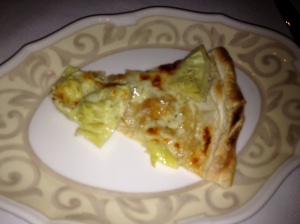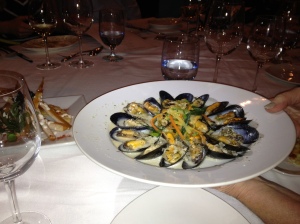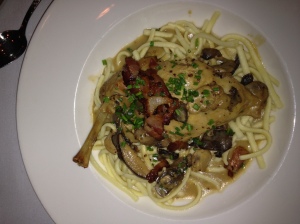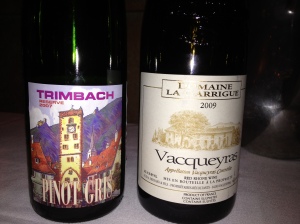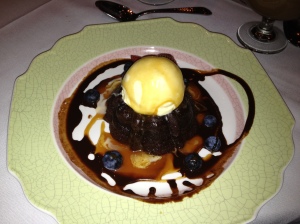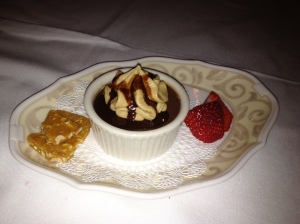As you probably know, those old Betty Crocker rules about red goes with beef, white with fish have gone down the drain faster than year-old Beaujolais Nouveau. (Free tip: vociferously expressing disdain for Nouveau in a reputable wine establishment can score you a free bottle of real Beaujolais from the Proprietor. I ain’t telling you where this went down; I want to try that grift again sometime. But I digress.)
Newsflash: it’s acceptable to drink whatever you want with whatever you eat, wherever you may be eating it, whomever you might be eating it with. If I were one of those super-cheesy wine writers for the Examiner.com, I’d say vino la difference! But that would make you and me both gag. As the customer, you’re paying good money for the privilege of enjoying a memorable meal—not for the privilege of impressing a waiter.
You are, however, paying for the right to ask the establishment for the professional opinion of the server, wine steward or the sommelier (someone who picks out the restaurant’s wine list) over to help you out. This service is part of the markup you pay on wine, which I’ll explain below.
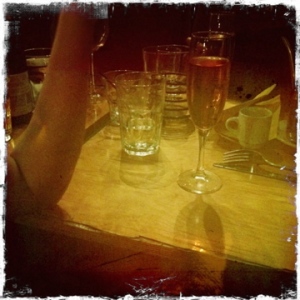
Gotta break up all this copy with something, right?
Wine professionals love what they do (c’mon, they drink for a living.) They have to, because they sure ain’t getting paid major bank for it. They’re happy to tell you about their picks, and they want to make sure you’re happy with what you’re drinking. So, don’t be afraid to ask. And don’t be afraid to ignore what they say if you don’t like what they say. Seriously. No kidding. The sommelier’s job is to make sure you’re happy and confident with whatever wine you order, even if they might not agree with it.
And if you get any stink-eye from anyone, discuss it nicely with the manager. Maybe he’ll comp you a dessert. If not, Yelp how you got food poisoning from that place and to avoid it at all costs. I’M KIDDING.
The proper cork-sniffing method
Not cool. Don’t do it. Moving on…..
Buy the bottle? Or buy the glass?
Unless I’m broke this week and can’t sell any more plasma, or it’s a work night and I know should “be a responsible adult” and limit myself to one bottle drink (HA), I’m reluctant to order wine by the glass in most restaurants, for several reasons:
1. You can’t guarantee the quality. You don’t know when that bottle was first opened. You could be paying top dollar for wine that’s been open for more than a week. Oxygen is the enemy of wine, just like it is to your car. Air “rusts” wine.
Sure, it’s probably a given that Chez Snootez goes through bottles of wine faster than Wally’s Chow Mein World. But I’ve had wine that’s clearly gone off at a big-time wine restaurant, where you would expect they’re opening new bottles every hour or so.
How to get around this:
Check the list and see how many wines they sell by the glass. If it’s somewhere between five and six each for reds and whites, then it’s likely the bottle hasn’t been there that long. Any decent place should mark the bottle when it was opened. It doesn’t hurt to ask, but know in advance that you might not get a firm answer. Or a true one.
If you’re not the adventurous type, order the kinds of wine most people have heard of: Chardonnay, Cabernet, Pinot Noir, and so forth. These bottles turn over faster. People tend to go with what they know in a restaurant, whether because wine is “intimidating” or because it’s too expensive to encourage experimentation. It’s a shame, frankly, because there are many terrific Malbecs, Gruner Veltliners, and Nebbiolos out there by the glass. (Seriously, try something new, won’t ya?)
Angle for a sample. Some restos that love their winos will pour you a half-ounce or so if you seem nice enough or likely to tip big, or dither over what to order in a charmingly befuddled way. Best of all, they won’t charge for it. The trick is you want them to bring it to you without asking for it so it’s their idea and you can act all surprised and “oh, gosh, for ME? You are SO SWEET!”
Finally, don’t ever order the “house” anything. Because it’s not what the house recommends. It’s whatever they got cheap from their distributor who needs to unload 4,000 cases that nobody wants to buy.
2. By the glass, you can’t guarantee the accuracy. When you order a bottle, you see what you’re getting when the waiter comes to your table to open it. He lets you inspect the label beforehand. If you order a glass, the waiter doesn’t bring the wine bottle from behind the bar and uncork it in front of you. Ninety-nine times out of 100 it shows up to your table already poured into your big-girl glass. How do you know that was the Australian Shiraz and not the Sonoma Syrah? The 2007 instead of the 2009? You have to take it on faith that they didn’t make a, ahem, “mistake” and pour the wrong/cheaper wine—and charge you the expensive price.
How to get around this: get a job in the wine industry that requires you to taste 25,000 wines year, and become a Master Sommelier which will basically make you a blind-tasting ninja that can identify what type of gravel the grapes were grown in. Sadly, I’m not kidding too much on this.
3. Economics 101: Bottles are better buys than glasses. One bottle can yield about a glass and a half apiece for a table of four moderate drinkers, or about six glasses for the highly motivated solo diner.
One now-closed local place known for its 43-page wine list charged $15 for a glass of 2005 Fess Parker Pinot Noir. The bottle listed for $60. You’d spend $90 to get the same amount of wine by the glass. It retails for about $20. Yikes.
Here’s what to do:
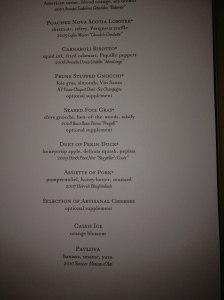
This was dinner on my last birthday. A couple of the wines on this list are $17 a bottle retail. The cost to get the wine supplement with dinner was much, much more.
That’s pretty close to the wholesale price the restaurant paid for the bottle. So when I see that Chez Snootez is charging $40 for a wine I paid $10 for at Slappy McPacky’s Plonk Palace, that wine goes on my “pass” list, regardless of how much I may love it.
Divide the bottle price by two or three, or in some fancy-schmancy restaurants, five. That’s how much you would pay for the bottle retail if you went to Slappy’s for it. Oh, and BTW: Some diners will order the second least-expensive wine on the list so that they don’t look like a total cheapo in front of their client, boss, date, or parents. Unfortunately, restaurants know this thanks to that voodoo human psychology thing. These are usually the bottles with the highest percentage markups.
Experiment, dammit! People tend to go with what they know. They just want to drink their Chardonnays, Merlots, Pinot Noirs, Cabernets, and so forth in peace. So restaurants know the usual suspects are no risk to put on the wine list because people will order them (and pronounce them with confidence). So it’s safe to mark them up more than a bonardo, lagrein, or txacoli (say chock-oh-lee).
Don’t just stick with California, Italy and France. There are tons of great values to be had in Argentina, Chile, New Zealand, Spain, Austria, South Africa and Croatia (yes, seriously—Croatian wines are off the hook. Look for ones by Movia especially) because they’re not the first choice in the consumer’s mind.
Why is all this the way it is?
Food is perishable, and profit margins are low. Booze is a cash cow (hey, wine is worth more the older it gets, riiight?) Restaurants aren’t trying to rip you off (at least not all of them). They’re just trying to stay in business. Wine takes up a lot of valuable real estate in a restaurant. They need to stock special big-girl-and-boy glasses, which can break easily. They need to open bottles to train staff to know what’s on the list and what to recommend. They need to build in enough of a profit cushion so that if a bottle truly tastes like horse-butt (see below) that they don’t lose a good wad of cash on it. Because not only will that bottle have to go back to the distributor because it’s bad, all of its siblings in the case that came with it probably have to go bye-bye too, back to the magic wine farm where it can live happily, play, and frolic with all the other problem wine bottles. (You know where that farm is, right? It’s next to the one your parents took your never-endingly barking dog to when you were away at day camp…oh shit, those were my folks.) So restaurants take advantage of the quirks in human nature that make most of us predictable (see psychology, human above).
What if the wine sucks?
Does it really suck? Or are you being a Picky McPickerpants? If you don’t like what you ordered, that doesn’t mean the wine is tainted or corked. Oh, and “corked” does not mean “little itty-bits of cork doing the backstroke in your glass.”
THIS is what corked is: Does the wine blatantly smell like wet cardboard or wet basement? Does it smell like stanky gym socks or the wrong end of a horse in August? Does it taste like paint thinner or vinegar? Does it look dull? If yes to any the above, you likely have a bad glass or bottle. And you may ask the sommelier or server that it be replaced. And they will do so, promptastically.
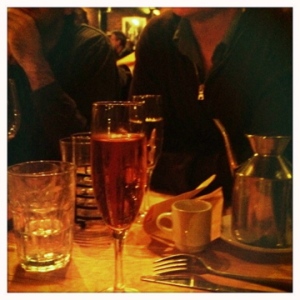
And yeah. Here's another break-up-the-page shot.
In high-end classy places, the somm will take the first taste before presenting the bottle to you to ensure it ain’t any of those things, especially if it’s a very expensive bottle. No, they’re not leeching a freebie off you. They’re making sure your evening isn’t ruined by horseass. Be grateful for that. Trust me on this one.
If you don’t like the wine, swirl it around for a minute. Let it rest. Try it again. Sometimes a little air can help even the hard edges out (yes, I know I called it an enemy of wine 57 paragraphs before this…let’s call it a frenemy). Still no good? Then you’re just a damn picky bastard and will probably get your meal spit on by your server in the back. Kidding again.
Don’t pass it around your party of twelve after you’ve approved it asking “do you think this is off?” and expect a freebie from your server. If the glass or bottle is less than 3/4 full, that wine is yours, sucka.
If it’s a red wine, ask for a glass of Coke. Mix it half-and-half and voila, you’ve got kalimotxo (kal-LEE-moe-cho) a Basque sipper that’s big with stateside wine hipsters. The white equivalent would be with Sprite or sparkling lemonade, caliguay. Do either with a bottle over $150, and you’re a wine anarchist.
If you’re really bummed out by your wine selection, treat yourself to dessert. And cocktails.
Tl, dr
Be a little adventurous, ask questions, don’t get hung up on the “rules” or the lack of them. Just have fun, enjoy the company you’re in, and be glad you can afford to go out to eat well, because, hey, the economy stinks.
Just shut up already, and tell me what I should get!
Sometimes, the stakes (steaks?) are high and you’ve got to impress that paid escort, client, rich elderly uncle, or special someone. When you can’t, or don’t want, to bring in the restaurant’s wine expert, here’s how to finesse it:
• Order wine that comes from the country of the type of food you’re having. More commonly called “if it grows together, it goes together.” Italian food + Chanti. . . get it?
• Don’t be scared of wines you can’t pronounce. Just point to it on the wine list, or say its list number.
• Pinot Noirs go well with both meat and seafood.
• Tart wines, like Sancerre from the Loire, go with any food that needs a lemon to cut through the richness ( think heavy cheesy buttery sauces) or even has lemon in it. I can’t tell you the science on that one and why it works, but it does.
• A medium-bodied Burgundy can pair with a lot of different dishes.
• If everyone has seafood, stick with a Sauvignon Blanc or Gruner Veltliner.
• Avoid Pinot Grigio and Chardonnay. People drink them like water substitutes (and some of them taste like them, too). The wrong one can really make your meal taste nasty. Besides, the Chard will usually be overpriced.
• Wines from Europe tend to have more subdued, even tastes. Wines from the New World (America, Australia, South America) are bigger and bolder and can be real roller-coasters of spice and flavors. If you don’t want your wine to claw itself out of the glass and smack you upside the head, stick to the Old World.
• Order expensive bottles earlier in the evening. You may only need one bottle with your dinner. If you want more wine as the meal goes on, you can go cheaper, when you’re less likely to be sober and savor what you’re drinking. It can also save you from sticker—and ticker—shock when the check arrives.
Happy sipping!
Tags: dining, drinking, retail, sommelier, wine list



